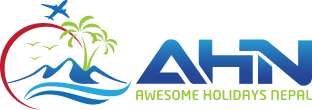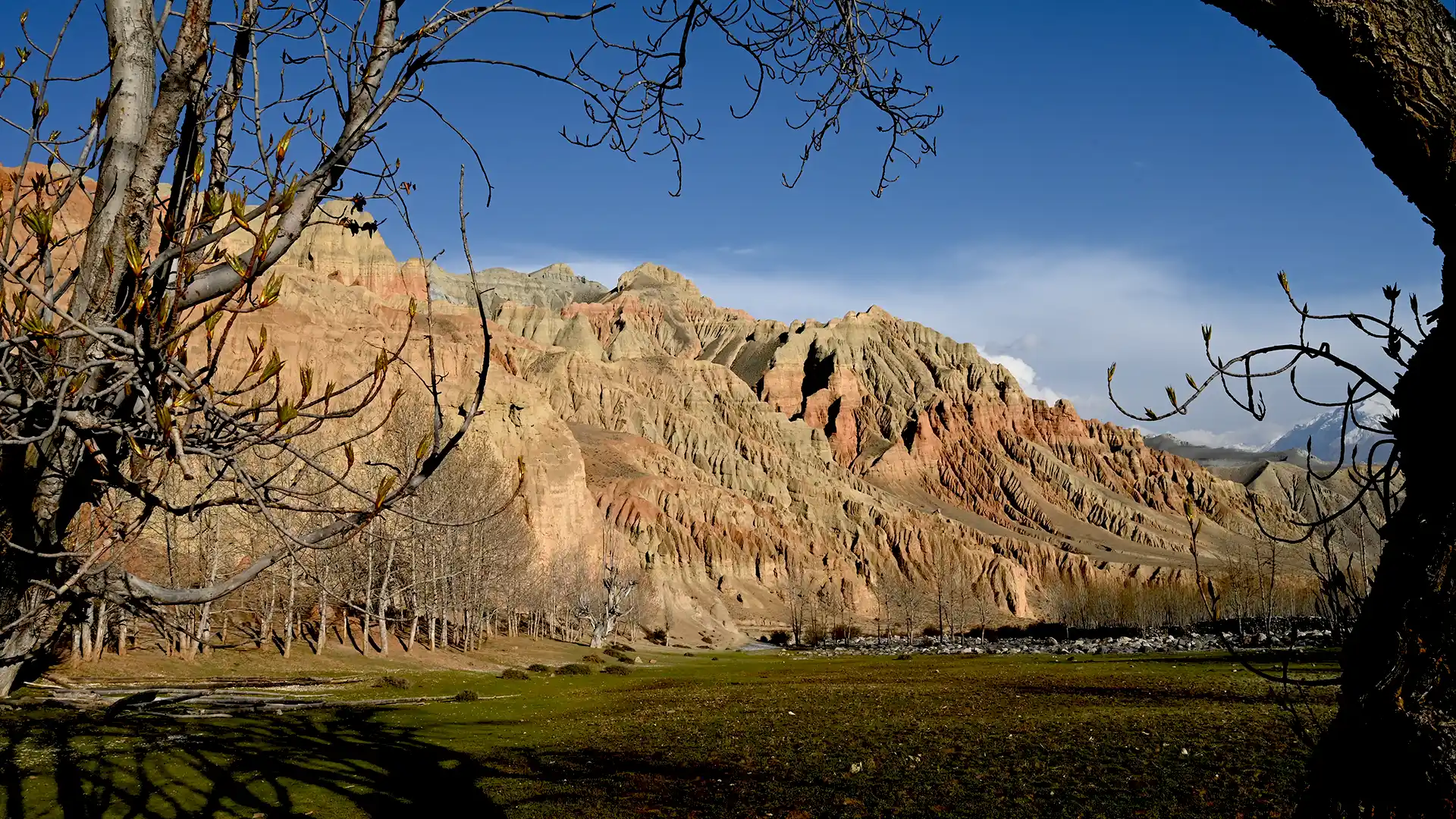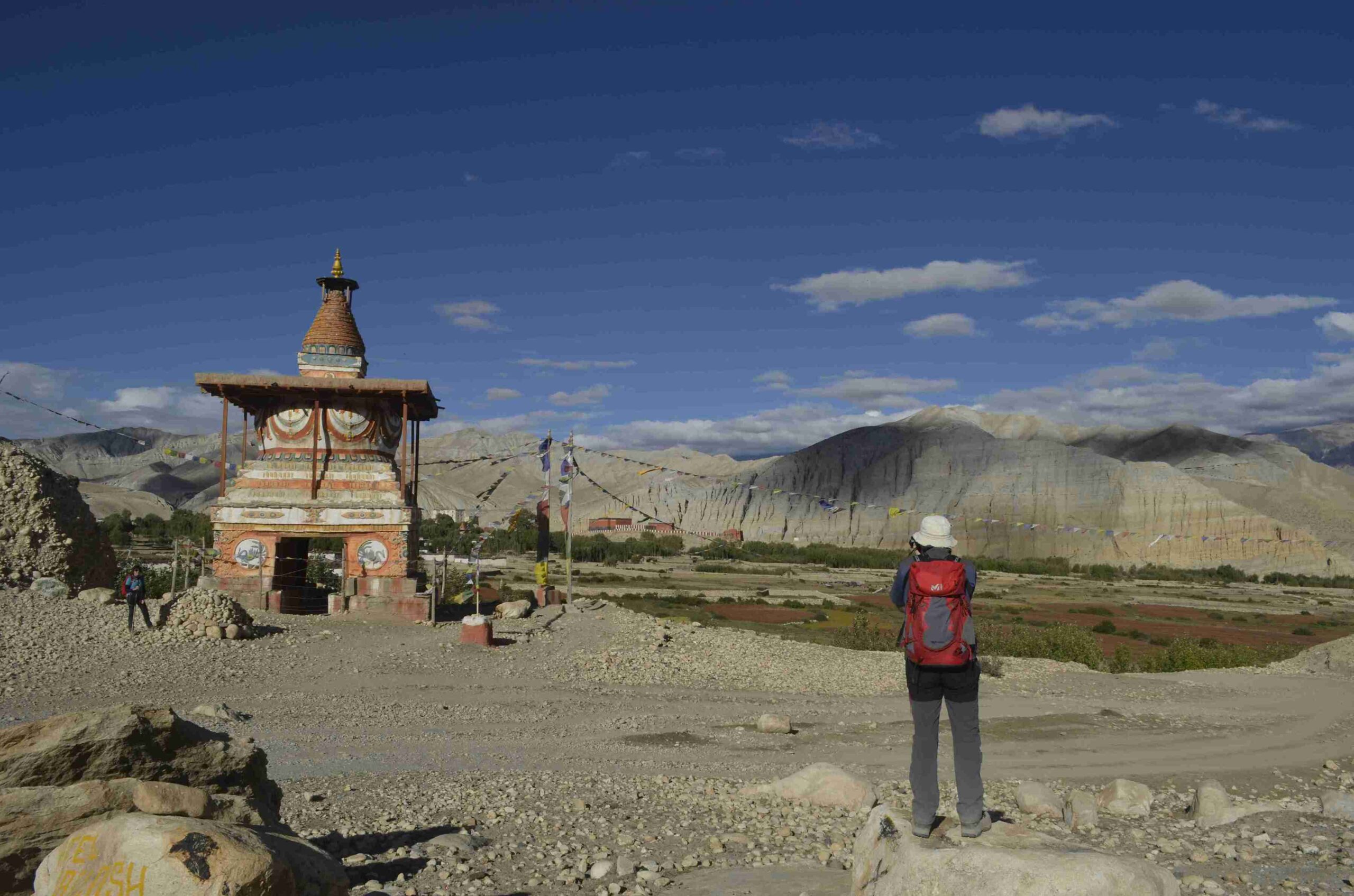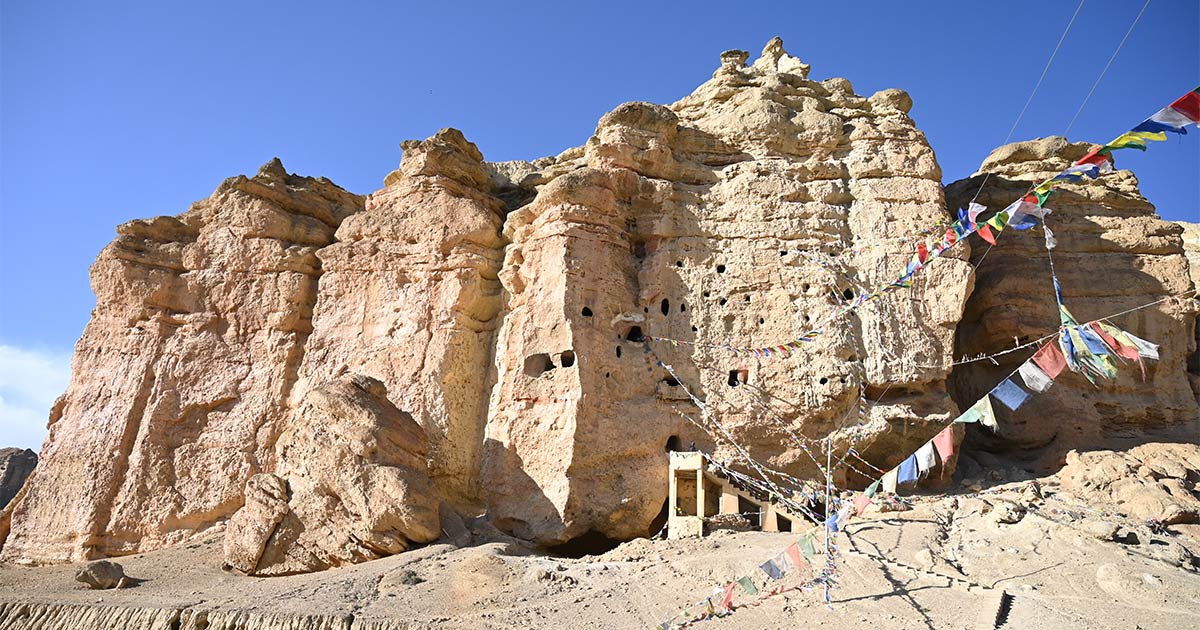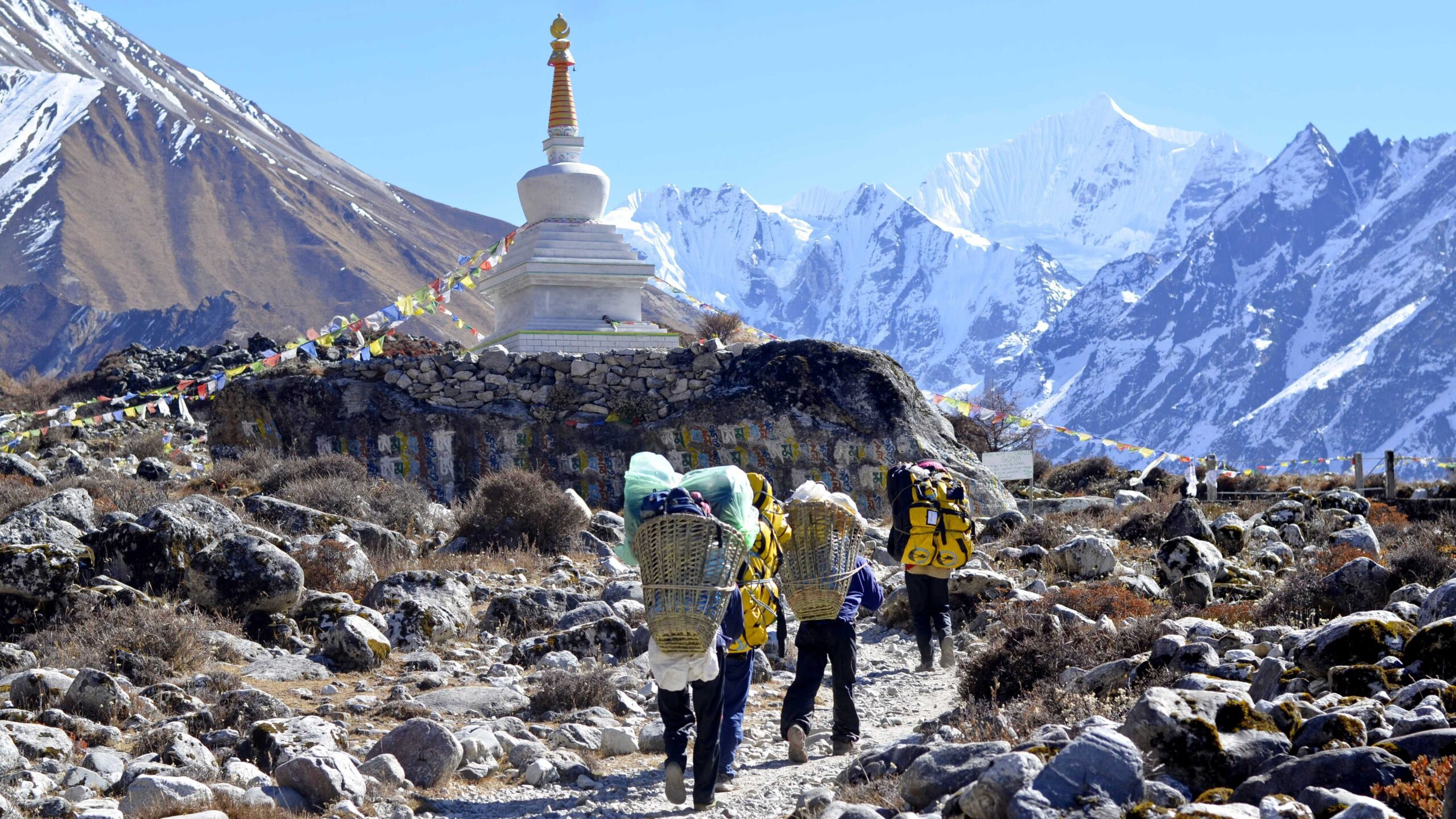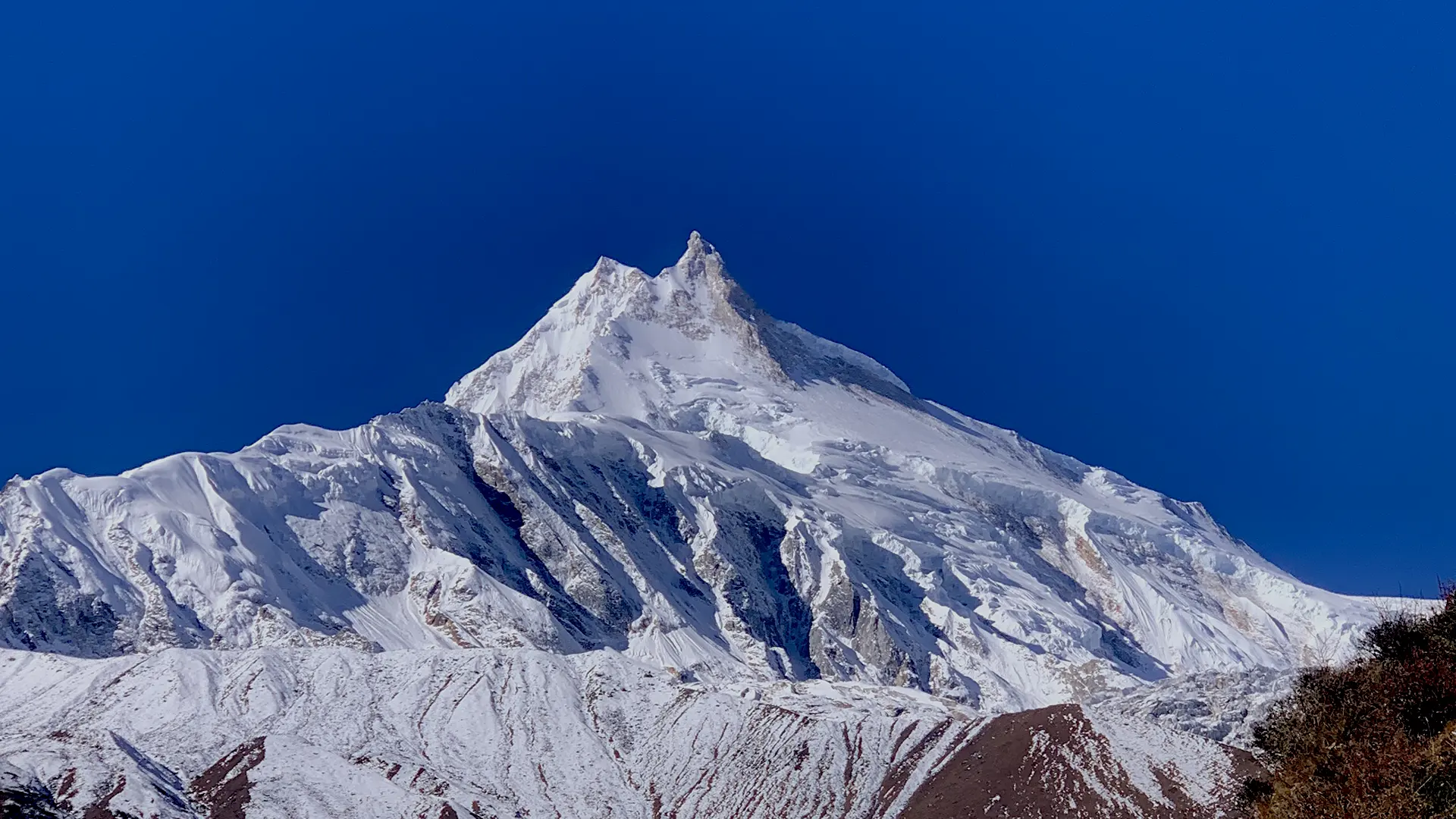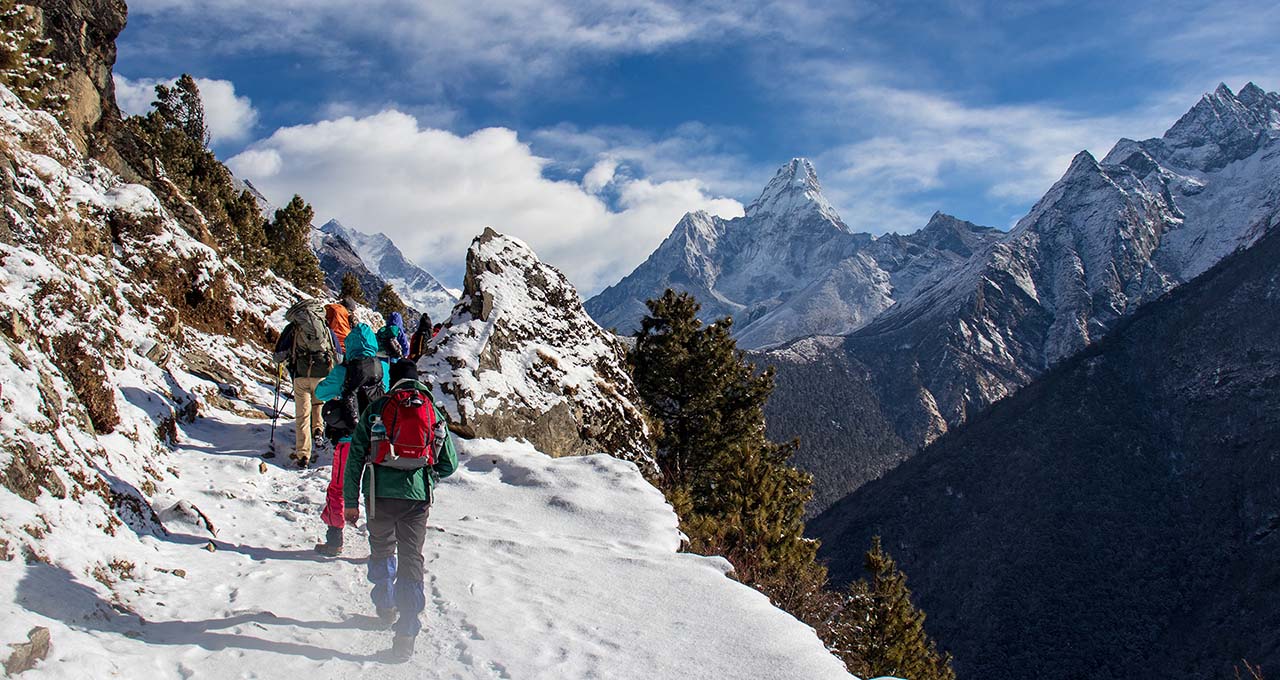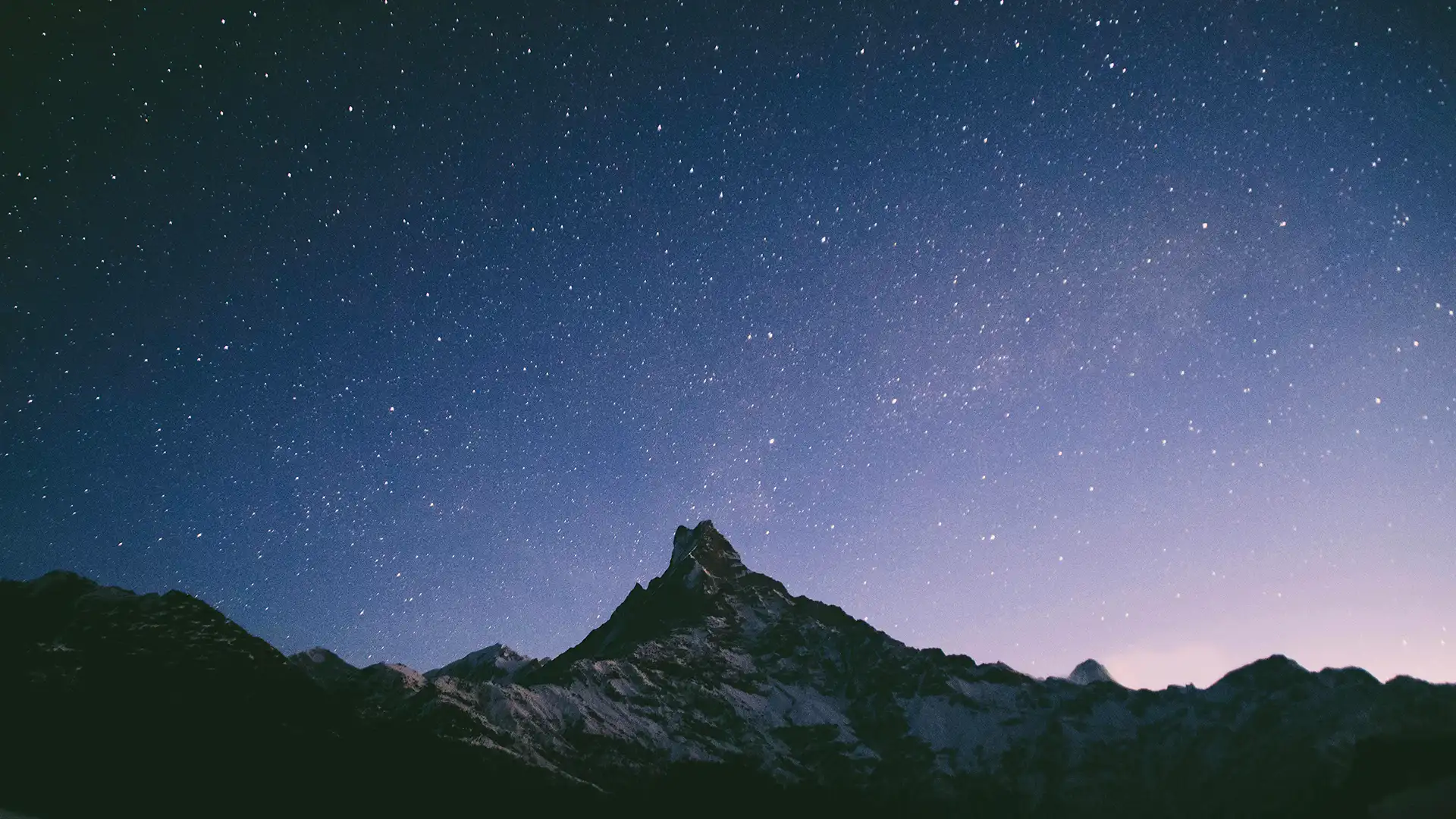Upper Mustang Region
The Upper Mustang region, also known as Nepal’s ” Lost Kingdom,” is a place you mustn’t miss exploring. From ancient stories of people to Chhoser caves that give off a vibe of Maya civilization, this place has much more to offer visitors. It is truly a rare experience to indulge in an experience that offers adventure but also a deep insight into once a forbidden culture and people.
Why Upper Mustang Region?
The Upper Mustang Region is the best way to explore the preserved landscapes of Lo Manthang, once a hidden kingdom of Nepal. This remote yet mystical region is rich in Tibetan culture, displayed well through preserved villages, monasteries, and festivals. Trekking through the Upper Mustang region takes you closer to Tibet, as the area is still geographically part of the Tibetan plateau and borders the country, too.
The trek to the Upper Mustang region takes you through Mustang’s arid and dramatic landscapes, consisting of towering cliffs, deep gorges, and windswept Kali Gandaki valley. You will also get a chance to immerse yourself in authentic traditional culture, live in medieval villages, and cross the high mountain passes for the most iconic mountain views.
Highlights of the Upper Mustang Region
- Lo Manthang, the ancient walled city of Upper Mustang, which was once the capital of the Kingdom of Mustang.
- High Mountain passes like Yamda La and Nyi La pass that offer panoramic views of Mustang and the surrounding Himalayas.
- Visit the ancient monasteries, chortens, and historical heritages to sink into the region’s spirituality.
- Trek through unique landscapes, deserted red cliffs, and arid deserts with a view of the mountains.
- Tiji festival trek that gives you a glimpse of the Tibetan Buddhist culture of the region.
- Sky caves in the Upper Mustang region that tells a history of many civilizations.
Top 10 Things to Do in the Upper Mustang Region
1. Explore the Royal Lo Manthang Palace
Standing out as the historic landmark of the hidden kingdom of Lo Manthang, the royal palace is a major center of attraction in this region. From architectural wonders representing traditional art forms to ancient relics representing the culture and lifestyle of the people, there is so much to explore.
It is said that the palace used to be the royal residence of the King who ruled this unknown land. Thus, you will see many ancient royal artifacts, Thangka paintings, and religious relics adorning its walls.
Even though the building looks old and rustic, the value it holds for the local residents is immeasurable.
2. Pay your Respects at the Monasteries
The Lo Manthang area is affluent when it comes to monasteries that uphold religious values and preserve culture. Numerous monasteries are in the walled capital city, each with rich spiritual and cultural significance.
Among them, the three major monasteries are the most prominent and most famous in the region, including Jampa Monastery, Thubchen Monastery, and Chode Monastery. All these monasteries belong to the Sherpa sect of Tibetan Buddhists and are located around the city.
Similarly, the Dragkar Thegchen Ling Gompa is another infamous monastery of Lo Manthang. This Gompa was believed to have been built in the 13th century when the land was still called the Kingdom of Lo.
3. Celebrate Tiji Festival at Chode Gompa
Tiji festival is a big deal at Chode Gompa, located inside the walled city of Lo Manthang. Many pilgrims visit the Upper Mustang region for this festival and celebrate it with grandeur. The festival’s name is a short form for Tenpa Chirim, which translates to prayer for world peace.
According to historical legends, the culture of celebrating this festival started three centuries ago and has been a ritual since then. Usually celebrated in May, the festival lasts three days and represents the victory of good over evil. The festival is meant to acknowledge two legendary figures, Dorje Jono and Padmasambhava.
The festival commences at noon on the first day with a musical announcement with large horns, drums, and cymbals. This continues to the “Tsa Chaam” dance in the evening, which tells the story of Dorje Jono and how he overcame evil. Monks perform the “Nga Cham” dance the next day, telling how the legend tried to return the demon to Buddha.
On the final day, masked people dance to the ceremonial music, and the dance performance is called “Rha Chaam. All performers come out on this day and dance to the music. The monk, acting as Dorjee, throws a representation of the evil made out of Barley.
4. Visit the Sky Caves in Chhusang
Another captivating scene of the Mustang region is the sky caves inside the red cliffs surrounded by tall mountains. According to legends, these caves were built over different periods of time, each for a different purpose. Before 1000 B.C., these caves were used to bury the dead, whereas later in the 10th century, they served as a hideout for Tibetan families who escaped wars.
In the Chhusang village, you can observe these caves, which give a vibe of Mayan civilization. This picturesque valley is a small settlement at an elevation of 2980 meters from sea level. Apart from the historical man-made caves, you can also enjoy the stunning landscapes and experience the local culture in this village.
5. Walking Tour of the City
The first and foremost thing to do as soon as you arrive in the walled city of Lo Manthang is to explore it on your feet. Built in the 15th century, the narrow alleys, white-washed rustic houses, stupas, and monasteries that look like rigged buildings are the highlight of the city.
You can also take a horseback ride to explore the city and make pit stops to click some pictures as a memoir of the journey.
6. Pilgrimage of Muktinath
While en route to the Upper Mustang region, you can stop at the lower elevation areas of Mustang and visit the Muktinath temple. Many Hindus visit this temple during trekking seasons to pray to the lord Bishnu, while Buddhists visit here for their deity Avalokiteśvara.
It is believed that pilgrims visit the temple to seek liberation. Legends have it that many sages came here to perform penance and gain liberation. Some visitors also come to perform a ritual for family members who have died in a place called Kagbeni, which lies on the route.
7. Hike or Go Cycling to Tilicho Lake
Once known as the highest lake in Nepal, Tilicho Lake is a high-altitude lake situated at an altitude of 4919 meters from sea level. Geographically, the lake is in Manang district, but you can easily reach it from Jomsom in Mustang.
Explorers usually prefer to trek to the lake from Jomsom, which is just 13 kilometers away. Some even go for a bike ride, as the elevation and rocky terrain are challenging enough for adventurers who love cycling.
8. Visit Apple Orchards and Try Dried Apples
The upper Mustang and the whole Mustang district are infamous for apple farming and products made from it. From dried apples to fermented liquors made from apples, the region is quite popular for apples.
Being in high-altitude terrain, the area is less likely to grow grains, but potatoes and apples are quite popular. In fact, many restaurants in Nepal serve a dish called “Mustang Aloo,” which translates to “Mustang Potatoes.” Even though the name is for the way of making the potatoes rather than the potatoes of the region, it honors the region’s produce.
9. Spend a Few Hours in Lowa Art Gallery and Book Shop
If you are passionate about art, especially Thangka paintings and other Tibetan arts, you mustn’t miss spending a few hours at Lowa Art Gallery. You can see the rich art and buy a few you want to take back as souvenirs.
Since it is also a bookshop, you can spend time learning about this Hidden Kingdom and Tibetan Buddhist culture. The bookshop is built in an old whitewashed building, so you will get a different vibe spending some time there.
10. Enjoy the Views from the Kora-La Border
Situated at an elevation of 4660 meters from sea level, the Kora-La border is a high mountain pass that was once used for trade between Tibet and Nepal. It is quite a famous route for salt trade between the bordering countries.
Coming to the present times, you can enjoy magnificent views of the Himalayan ranges from this pass. You can either ride a motorbike or take a Jeep tour to this border.
Trek With Awesome Holidays Nepal
Anyone can take you on a trek, but not all can lead your path with the utmost comfort and memorable encounters! Awesome Holidays Nepal is one such travel and trek company dedicated to curating tailor-made treks suited to your needs and utmost comfort while keeping your safety a prime concern. Based in Nepal, Awesome Holidays has a team of experts who have decades-long experience guiding guests through many adventurous yet luxurious expeditions.
Following are some of the prime reasons why you should trek with AHN:
- Awesome is committed to your travel needs.
- Travel Safety is always our primary concern.
- Our tailor-made itineraries offer the best value for your money.
- Awesome offers the flexibility to customize your treks based on your needs.
- A team of professionals who are always there to aid your trek and travel experience.
- Awesome Holidays Nepal is trusted with over a 95% success rate and excellent Travel Advisor Reviews.
- An ever-ready support team always backs up while on a trek.If you want an Awesome trekking experience, then you should definitely travel with Awesome Holidays Nepal.
How to Get to the Upper Mustang Region?
Starting from Kathmandu, you can get to the Upper Mustang region via flight or a scenic drive through varying terrains of the country. You can take a flight from Kathmandu to Pokhara and then from Pokhara to Jomsom Airport in Lower Mustang. From here on, you can continue on foot or drive to Upper Mustang in an SUV.
There is also an option to drive all the way from Kathmandu to the hidden kingdom. Mostly, people fly to Pokhara, then get a drive to Lower Mustang, and then trek their way up to the upper region.
Best Time to Visit the Upper Mustang Region
Fall and Spring are the best seasons to trek to the Upper Mustang region, similar to most Himalayan areas. Since the climate is suitable, the trails are dry, and the skies are clear during these two seasons, it is also the best season for climbing to the Himalayan regions of Nepal. Usually, during September-November and April-May, most visitors ascend through different trekking routes of the Upper Mustang region.
Food and Accommodation in the Upper Mustang Region
Accommodation in the Upper Mustang region primarily comprises Teahouses and local homestays with clean rooms and washrooms. These teahouses offer all basic facilities such as clean rooms, internet, hot showers, and other basic amenities at a reasonable price.
Similarly, the food on the way to this destination might vary depending on the urbanization in the area. However, the staple Nepali dish, noodles and soup, are quite common delicacies. As you ascend to a higher altitude, you will find Tibetan and Sherpa people and their food on your plates, too. Higher regions are dominated by Sherpa cuisine, including potatoes, pulses, soups, noodles, etc.
Explore Our Exciting Packages
Discover Unforgettable Adventures Await in Upper Mustang Region
FAQs
When is the best time to trek to the Upper Mustang Region?
The best time to trek to the Upper Mustang Region is during the Autumn and Spring seasons, as the climate is favorable and the trekking route is rich in luscious greens. For a safe, memorable, and incredible experience, plan a trek between mid-September and November or March and June.
However, the trek is possible all around the year. As long as you can avoid rainstorms and sustain extreme temperatures, you can ascend during colder months to avoid the crowd.
How long does the Upper Mustang trek take?
The Upper Mustang walking trek usually takes 16 days to complete, while the upper Mustang trek with Jeep takes 13 days to complete.
Do I need to book in advance?
Though it might not be mandatory, booking your upper mustang region trek in advance is better to ease the process, specifically if you plan for trekking seasons, as mentioned above.
Booking in advance secures your spot and ensures you and your trekking company are well-prepared for the trek. However, getting the trekking permits, booking accommodation and transport, and getting your visas might take time.
What kind of fitness level is required?
To trek to the Upper Mustang region, you will require moderate fitness since you will walk at least 6-7 hours daily. You will also need good cardiovascular endurance and muscular strength to ascend quickly through rough terrain.
If you aren’t somebody who doesn’t perform physical training regularly, it is better to start training at least ¾ months in advance. Ensure you include cardio, flexibility exercises, and strength training in your workout to prepare your body for the trek.
What permits are required?
To explore the Upper Mustang region, you require three different permits: a special Mustang trek permit, an Annapurna Conservation Area project permit, and a TIMS card (Travelers Information Management System).
Do I need travel insurance?
Taking travel insurance to trek the Manaslu circuit or the Upper Mustang Region isn’t mandatory. Still, it is advisable to do so to prepare in advance for possible catastrophic situations on the trek.
Can I customize my itinerary?
Yes, you can customize your itinerary for the Upper Mustang trek to fit your needs. We can add or subtract the acclimatization days, optimize the trekking route, and shorten or elongate the trek as you prefer.
However, if you have booked for our regular trekking package that moves as a group, customizing the itinerary just for an individual isn’t possible.
What is the best way to train for the trek?
Some of the best ways to train for the trek are through regular cardio, focusing on breathing exercises, strength training, lifting weights, hamstring sketching exercises, and so on. You can also switch to climbing stairs instead of lifts, walking, or jogging instead of driving to smaller distances to prepare your body.
Additionally, going on regular hikes or climbing up the hills can be the best way to train for the trek.
What kind of gear do I need?
To trek to the Upper Mustang region, you will need lightweight and warmer clothing, trekking poles, hiking boots, headlamps, sleeping bags, sunglasses, toiletries, and solar batteries.
Do I need vaccinations?
Getting any vaccinations to trek to the Upper Mustang region isn’t mandatory. However, you can check your country’s travel regulations and vaccinate yourself before visiting Nepal.
Typically, routine vaccines are available, including those against Malaria, Japanese Encephalitis, Hepatitis A, Hepatitis B, Typhoid, Rabies, and Cholera.
What currency should I carry?
For any personal expenses other than those offered by the trekking company, you will need Nepalese rupees for your Upper Mustang trek. However, having some USD or your home currency as a backup for emergencies or returns is better.
Exchange your currencies for Nepali rupees in Kathmandu to find the best rates.
Do I need a visa for Nepal?
To travel to Nepal, you will need a “Tourist Visa.” This visa is available on arrival for most foreign visitors except those from African countries, Afghanistan, and refugees with travel documents.
Check the official website of the Department of Immigration for information regarding On Arrival and other tourist visas in Nepal.
Is it possible to trek solo?
Traveling to protected areas like the Upper Mustang region requires at least a two-person team to get the permit. So even if you are courageous enough to travel solo, it isn’t possible to do so in Upper Mustang. Besides, traveling solo requires additional physical and mental strength despite being an exciting and exhilarating trek at the same time.
What is the trek route like?
The trekking route to the Upper Mustang region consists of rough rocky terrain, a couple of steep hills, stairs, and narrow trails. Along your path, you will encounter suspension bridges, a biodiversity conservation area, luscious green forests, and locally inhabited villagers.
What kind of accommodation is available?
While standard, three-star, and five-star accommodations are available in Kathmandu and Pokhara, the options might be restricted on the trekking route. Some of the popular stops in the major trekking regions, like Everest, Annapurna, and Manang, have an option of luxury lodges. You will most likely find tea houses with clean rooms in the rest of the areas.
How do I get to the starting point?
If you want to trek through the Upper Mustang region, you can reach the starting point, i.e., Jomsom, via flight or on a jeep ride.
Is there electricity and Wi-Fi available?
Yes, electricity and Wi-Fi are available in most of the teahouses en route to the Upper Mustang region trails. However, it might be costly to access internet services and charge your devices at these stops, and the reliability of the connection could be better, too. You can carry rechargeable solar batteries for electricity.
How much luggage can I carry?
Since you will be traveling on a bus and then hiking along the trekking route, there is no restriction on the luggage you can carry. However, it is better to travel light as you will have to carry along the trek.
What is the food like on the trek?
The guesthouses and teahouses primarily serve Nepali, Tibetan, and other ethnic cuisine, including Rice, Pulses, Bread, Noodles, and Soup.
Are there showers available?
Yes, showers are available on the trek to Upper Mustang, but it’s recommended that you avoid showering at higher elevations.
Can I charge my electronics?
There are provisions for charging your electronics in rest houses, teahouses, or local stays. But remember to carry the required adapters (C type and D type) with you to fit in your chargers.
What kind of toilets are available?
The teahouses en route to Upper Mustang offer clean yet basic squat toilets. For emergencies, private spots along the trail can also be used if needed.
Luxury hotels, however, typically provide modern amenities such as Western-style commodes, ensuring greater comfort for travelers.
Is it possible to do laundry on the trek?
Yes, doing laundry on the trek to Upper Mustang region is possible. However, the water is cold, so we suggest you do not use it unless required. Packing enough clothes is better than looking for laundry in elevations with cold water.
Can I buy snacks and drinks on the trek?
You are less likely to find a store to buy snacks and drinks on the trek as it is a remote area inhabited by fewer people. However, the tea houses along the trail do sell biscuits, candies, and other snacks.
We advise you to carry protein bars, dried nuts, and fruits to snack when you want. For drinking water, you can bring a refillable bottle with a filter to drink water from sprouts or springs along the way.
Are there ATMs along the trail?
Yes, you can find a few ATMS in Jomsom, but none are on the trekking trail.
How do I deal with altitude sickness?
If you get altitude sickness on your way Upper Mustang, let your trekking guide know about the situation. The guides are prepared with first aid required for such a situation.
Rest at the same spot and take anti-sickness medications. After you feel a little better, descend to a lower altitude. If the situation worsens, request the guide reach out to the head office in Kathmandu for a helicopter rescue.
What should I pack for the trek?
It would be best to pack warmer clothes, trekking gear, all your necessary medications, and travel documents for the trek. Additionally, you should pack protein bars, dry nuts, and fruits for snacking on the trek, along with a refillable water bottle.
Even though the company will provide you with packaged water bottles along the journey, it is convenient to carry your own.
Are there medical facilities along the way?
Medical facilities are very limited on the trekking routes of the Upper Mustang except in towns like Jomsom. We suggest you carry all necessary medications in your backpack before you drive to the base.
Is it safe to drink the water?
Water from natural sources looks clean in the Upper Mustang region, but it might not be safe to drink. You can purify the water using bottle filters, chlorinate it, or boil it to make it potable.
What should I do in case of an emergency?
The first thing you can do in an emergency is contact our trekking guide. Our guides are equipped with oximeters and necessary first-aid kits and trained to handle any kind of emergency.
Besides, the guides will have all the necessary contacts to contact emergency rescue services such as helicopter rescue, air ambulance, or land rescue.
How can I prevent altitude sickness?
The best way to prevent altitude sickness is by taking proper rest after your trek, acclimatizing to the altitude, staying hydrated, and avoiding alcohol while on the trek.
What should I do if I experience altitude sickness?
Whenever you feel sick due to altitude, stop immediately and rest for a while. Hydrate yourself and take medications to ease the pain.
You should never try to ascend or descend right away whenever you are experiencing altitude sickness. Let your trekking guide know about your situation and request an emergency rescue if the condition worsens.
What medications can help with altitude sickness?
Acetazolamide (usually sold under the name Diamox) can help you with altitude sickness. As it reduces the severity of any observed symptoms as well as helps you adjust to high altitude quicker, Diamox is often suggested to treat acute altitude sickness.
Some other medications that can also help are Dexamethasone, Nifedipine, and Ibuprofen. It is safe to consult your physician and take the medications in advance to prevent allergies or any undesired reaction against the drugs.
What other health concerns should I be aware of?
You should be aware of any medical conditions that you might have before planning the trek. If you have pulmonary diseases, asthma, or any other breathing-related illness, it’s better to get it checked and prepared in advance with medication and stimulatory exercises.
Additionally, you should be aware of any allergies that you might have before you trek. It is always best to avoid food, drinks, or agents that can instigate a hypersensitive reaction in your body to prevent any illness on the route.
Is it safe to trek alone?
It isn’t too safe to trek alone in the wilderness. If you are planning to trek to high-altitude mountains like the Upper Mustang region, which can often have unpredictable weather, is prone to natural calamities, and involves risky and rough terrains, it isn’t safe to travel solo.
If you know the route very well and are mentally and physically prepared to trek alone, go for it. Otherwise, it is recommended to take along a travel guide who knows the route well to have a smooth trekking experience.
What should I do if I get injured?
If you get injured during the trek, stop for a break and take the necessary first aid. If you have a serious injury that needs immediate attention, call for emergency rescue with the help of your trekking guide.
Are there any dangerous animals on the trek?
Since the trekking route takes you through conservation areas, it is obvious to see animals on the route. Although it is less likely to find a dangerous animal on the trail, it isn’t impossible. Leopards, cheetahs, musk deer, etc, can often inhabit mountainous regions.
Traveling in groups in such forest areas is better than coming across one. But if you did, don’t just run or instigate the animal; let it pass before you move.
What is the weather like on the trek?
The weather can be quite unpredictable if you are trekking in a mountainous region. Usually, the temperature is lower and can drop to freezing at night.
Besides, the higher elevation areas often have snow storms, soft rains, and chilled breezes.
